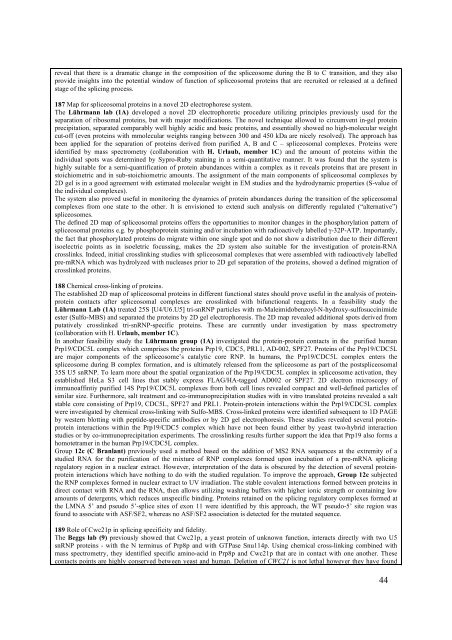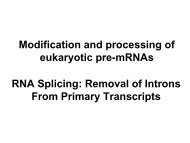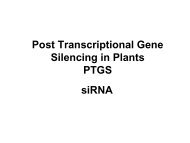Create successful ePaper yourself
Turn your PDF publications into a flip-book with our unique Google optimized e-Paper software.
eveal that there is a dramatic change in the composition of the spliceosome during the B to C transition, and they alsoprovide insights into the potential window of function of spliceosomal proteins that are recruited or released at a definedstage of the splicing process.187 Map for spliceosomal proteins in a novel 2D electrophorese system.The Lührmann lab (1A) developed a novel 2D electrophoretic procedure utilizing principles previously used for theseparation of ribosomal proteins, but with major modifications. The novel technique allowed to circumvent in-gel proteinprecipitation, separated comparably well highly acidic and basic proteins, and essentially showed no high-molecular weightcut-off (even proteins with mmolecular weights ranging between 300 and 450 kDa are nicely resolved). The approach hasbeen applied for the separation of proteins derived from purified A, B and C – spliceosomal complexes. Proteins wereidentified by mass spectrometry (collaboration with H. Urlaub, member 1C) and the amount of proteins within theindividual spots was determined by Sypro-Ruby staining in a semi-quantitative manner. It was found that the system ishighly suitable for a semi-quantification of protein abundances within a complex as it reveals proteins that are present instoichiometric and in sub-stoichiometric amounts. The assignment of the main components of spliceosomal complexes by2D gel is in a good agreement with estimated molecular weight in EM studies and the hydrodynamic properties (S-value ofthe individual complexes).The system also proved useful in monitoring the dynamics of protein abundances during the transition of the spliceosomalcomplexes from one state to the other. It is envisioned to extend such analysis on differently regulated (“alternative”)spliceosomes.The defined 2D map of spliceosomal proteins offers the opportunities to monitor changes in the phosphorylation pattern ofspliceosomal proteins e.g. by phosphoprotein staining and/or incubation with radioactively labelled γ-32P-ATP. Importantly,the fact that phosphorylated proteins do migrate within one single spot and do not show a distribution due to their differentisoelectric points as in isoeletric focussing, makes the 2D system also suitable for the investigation of protein-RNAcrosslinks. Indeed, initial crosslinking studies with spliceosomal complexes that were assembled with radioactively labelledpre-mRNA which was hydrolyzed with nucleases prior to 2D gel separation of the proteins, showed a defined migration ofcrosslinked proteins.188 Chemical cross-linking of proteins.The established 2D map of spliceosomal proteins in different functional states should prove useful in the analysis of proteinproteincontacts after spliceosomal complexes are crosslinked with bifunctional reagents. In a feasibility study theLührmann Lab (1A) treated 25S [U4/U6.U5] tri-snRNP particles with m-Maleimidobenzoyl-N-hydroxy-sulfosuccinimideester (Sulfo-MBS) and separated the proteins by 2D gel electrophoresis. The 2D map revealed additional spots derived fromputatively crosslinked tri-snRNP-specific proteins. These are currently under investigation by mass spectrometry(collaboration with H. Urlaub, member 1C).In another feasibility study the Lührmann group (1A) investigated the protein-protein contacts in the purified humanPrp19/CDC5L complex which comprises the proteins Prp19, CDC5, PRL1, AD-002, SPF27. Proteins of the Prp19/CDC5Lare major components of the spliceosome’s catalytic core RNP. In humans, the Prp19/CDC5L complex enters thespliceosome during B complex formation, and is ultimately released from the spliceosome as part of the postspliceosomal35S U5 snRNP. To learn more about the spatial organization of the Prp19/CDC5L complex in spliceosome activation, theyestablished HeLa S3 cell lines that stably express FLAG/HA-tagged AD002 or SPF27. 2D electron microscopy ofimmunoaffintiy purified 14S Prp19/CDC5L complexes from both cell lines revealed compact and well-defined particles ofsimilar size. Furthermore, salt treatment and co-immunoprecipitation studies with in vitro translated proteins revealed a saltstable core consisting of Prp19, CDC5L, SPF27 and PRL1. Protein-protein interactions within the Prp19/CDC5L complexwere investigated by chemical cross-linking with Sulfo-MBS. Cross-linked proteins were identified subsequent to 1D PAGEby western blotting with peptide-specific antibodies or by 2D gel electrophoresis. These studies revealed several proteinproteininteractions within the Prp19/CDC5 complex which have not been found either by yeast two-hybrid interactionstudies or by co-immunoprecipitation experiments. The crosslinking results further support the idea that Prp19 also forms ahomotetramer in the human Prp19/CDC5L complex.Group 12c (C Branlant) previously used a method based on the addition of MS2 RNA sequences at the extremity of astudied RNA for the purification of the mixture of RNP complexes formed upon incubation of a pre-mRNA splicingregulatory region in a nuclear extract. However, interpretation of the data is obscured by the detection of several proteinproteininteractions which have nothing to do with the studied regulation. To improve the approach, Group 12c subjectedthe RNP complexes formed in nuclear extract to UV irradiation. The stable covalent interactions formed between proteins indirect contact with RNA and the RNA, then allows utilizing washing buffers with higher ionic strength or containing lowamounts of detergents, which reduces unspecific binding. Proteins retained on the splicing regulatory complexes formed atthe LMNA 5’ and pseudo 5’-splice sites of exon 11 were identified by this approach, the WT pseudo-5’ site region wasfound to associate with ASF/SF2, whereas no ASF/SF2 association is detected for the mutated sequence.189 Role of Cwc21p in splicing specificity and fidelity.The Beggs lab (9) previously showed that Cwc21p, a yeast protein of unknown function, interacts directly with two U5snRNP proteins - with the N terminus of Prp8p and with GTPase Snu114p. Using chemical cross-linking combined withmass spectrometry, they identified specific amino-acid in Prp8p and Cwc21p that are in contact with one another. Thesecontacts points are highly conserved between yeast and human. Deletion of CWC21 is not lethal however they have found44







